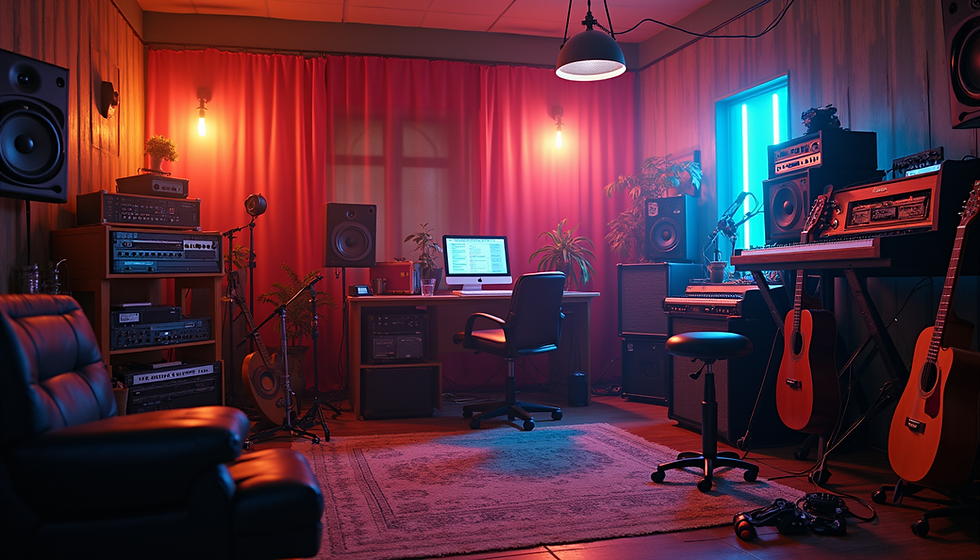Mastering Music Like a Pro: A Comprehensive Guide to the Mastering Process
- Cammo Network
.jpg/v1/fill/w_320,h_320/file.jpg)
- Apr 4, 2023
- 4 min read
Updated: Apr 13, 2023
Mastering is a crucial step in the music production process that involves enhancing the final mix of a track or album. Mastering engineers are skilled professionals who have a deep understanding of sound and use their expertise to bring out the best in a piece of music. In this article, we will explore the steps involved in the mastering process and provide a comprehensive guide to how mastering engineers work.

Listening Mastering engineers start by listening to the music carefully to identify any issues that need to be addressed. They use high-quality monitoring equipment to analyze the mix and identify any sonic inconsistencies, such as frequency imbalances or distortion. The engineer will listen to the track multiple times to get a sense of the overall vibe and energy of the music.
Corrections Once the engineer has identified any issues in the mix, they will use a range of tools and techniques to correct them. For example, they may use equalization to balance the frequency spectrum, or use compression to control the dynamic range. They may also use tools such as de-essers to reduce harsh sibilance or multi-band compressors to control specific frequency ranges.
Stereo Enhancement Mastering engineers may apply stereo enhancement techniques to the mix to make it sound wider and more immersive. This can be achieved through techniques such as stereo widening, stereo imaging, and reverb. Stereo widening involves widening the stereo image of the mix, while stereo imaging involves adjusting the placement of individual elements within the stereo field. Reverb can be used to add depth and dimension to the mix.
Dynamics Control Dynamics control is a critical aspect of mastering. It involves balancing the levels of different tracks and ensuring that the overall volume of the mix is consistent. Mastering engineers may use techniques such as limiting, compression, and normalization to achieve the desired result. Limiting involves setting a maximum level for the mix, while compression is used to control the dynamic range of individual tracks or the overall mix. Normalization is a technique that adjusts the overall level of the mix to a consistent volume.
EQ Equalization is an essential tool in the mastering process, allowing engineers to balance the frequency spectrum and remove any harsh or unwanted frequencies. This can help to improve the clarity and overall tonal balance of the mix. Mastering engineers may use a combination of parametric and graphic EQs to adjust specific frequency ranges.
Final Touches Once the engineer is satisfied with the sound of the mix, they will make any final touches to the track. This may involve adding fades to the beginning and end of the track, adjusting the spacing between tracks, and applying dithering to ensure a smooth transition between the digital and analog domain. Dithering is a process that adds noise to the audio signal to prevent quantization errors when converting the digital signal to an analog format.
Delivery The final step in the mastering process is delivering the finished product to the client. Mastering engineers will typically provide the client with a final stereo mix, as well as individual tracks for use in future productions. The engineer will ensure that the mix is optimized for the desired distribution platform, such as CD, vinyl, or digital streaming services. They may also provide the client with a master for use in creating copies of the final product.
Master Chain
Here is an example of how a engineer can structure his master chain: EQ - Equalization is a crucial tool in the mastering process, allowing engineers to balance the frequency spectrum and remove any unwanted frequencies. A professional mastering chain may use a combination of parametric and graphic EQs to adjust specific frequency ranges.
Compression - Compression is used to control the dynamic range of individual tracks or the overall mix. A mastering chain may include both single-band and multi-band compressors to achieve the desired result. Multi-band compressors are particularly useful for controlling specific frequency ranges.
Stereo Enhancement - Stereo enhancement techniques can be used to make the mix sound wider and more immersive. This can be achieved through techniques such as stereo widening, stereo imaging, and reverb.
Saturation - Saturation can be used to add warmth and depth to the mix. It can be achieved through analog tape emulation plugins or saturation plugins that simulate the sound of analog equipment.
Limiting - Limiting involves setting a maximum level for the mix. A mastering chain will typically include a limiter as the final plugin in the chain to prevent any clipping or distortion.
Dithering - Dithering is a process that adds noise to the audio signal to prevent quantization errors when converting the digital signal to an analog format. A professional mastering chain will typically include a dithering plugin as the final step in the chain.

It's worth noting that the specific plugins and techniques used in a mastering chain will vary depending on the preferences of the engineer and the requirements of the mix. Additionally, many mastering engineers will use a combination of hardware and software processing to achieve the desired result. Ultimately, the goal of a mastering chain is to enhance the overall sound of the mix, while ensuring that it sounds great on any platform, whether it's played on a home stereo system, a car stereo, or a set of headphones.
''One track masteringto commercial standards. Mastering quallity as any other track in top.50 Dance/ EDM/ Pop/ Hip-Hop charts''
In conclusion, mastering is a complex and technical process that requires a deep understanding of sound and a range of specialized tools and techniques. By applying corrections, enhancing the stereo image, controlling dynamics, using EQ, and making final touches, mastering engineers can bring out the best in a piece of music and create a final mix that sounds great on any platform.

.png)


